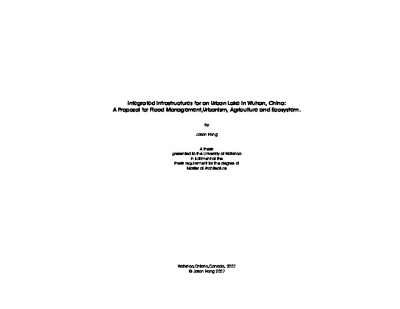| dc.description.abstract | One of the consequences of China’s rapid urbanization is the disappearance, or at least, mismanagement of the many lakes of the Central Yangtze River Basin. The thesis investigates the situation by conducting a complex system analysis, revealing four most pressing issues surrounding the lakes: flood management, sustaining agricultural practice, controlling urban development and maintaining a healthy ecosystem. The inadequacy in Central Yangtze River Basin’s flood capacity requires that the many lakes in the region be preserved and connected to form a flood retention network. Unfortunately, this preservation is threatened by urban development that seeks to infill the lakes. As well, many of the lakes are now divided into independent lotus farms and fish ponds which do not provide for a sustainable aquatic ecosystem. The city of Wuhan and its Lake Shahu is the focus of this thesis. Lake Shahu is a microcosm of the regional condition, and its centrality within the city of Wuhan brings about a particular set of problems, namely, the lake is perceived as an obstacle for communication and transit as well as an impediment for much needed city expansion.
The thesis proposes a solution to the complex problem surrounding Lake Shahu by synthesizing a system of integrated infrastructure which would reconnect the lake and the Yangtze River, as well as provide a flood berm, public spaces, lotus farms, fisheries, wetlands and an artificial platform as land for city expansion. The infrastructural system is to instigate a process of transformation which sets up a symbiotic relationship among elements on site. For example, the Land Over Water project will allow penetration of sunlight to sustain the ecosystem below while staging a lively urban life above and supplying the lotus farms below with grey water collected from households. The design approach, known as Landscape Urbanism, is exemplified by Field Operation’s Fresh Kills Landfill Rehabilitation project where agricultural techniques and strategic planting are used to create a diverse range of habitats and event spaces over the course of 30 years. In the case of Lake Shahu, the importance of agriculture is highlighted for its engineering potential as well as its economic capacity to support the remaining rural farming population in the area. Aided by the transformation of the landscape and given the tools for monitoring the lake’s ecosystem, the farmers and fishermen can eventually become stewards of the land and water.
Not unlike Fresh Kills, the project of Lake Shahu is staged for a 35-year period. The project evolves along the rapid development of China at a much slower pace as the natural processes required to stabilize the landscape will take a long time. By the end of the transformation, a sustainable system capable of adapting to changes in the urban, agrarian and natural environment will be able to support generations to come. | en |

